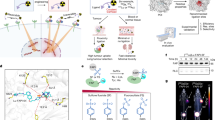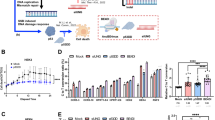Abstract
We have previously developed a recombinant adenovirus containing a fusion gene of Escherichia coli cytosine deaminase (CD) and herpes simplex virus type 1 thymidine kinase (HSV-1 TK) controlled by a cytomegalovirus (CMV) enhancer-promoter. This replication-incompetent adenovirus effectively transduced the CD-TK gene into human prostate adenocarcinoma DU-145 or PC-3 cells. Interestingly, heat shock at 41°C for 4 hours elevated the level of CD-TK by approximately 5- to 20-fold at a multiplicity of infection (MOI) of 1. Heat-enhanced expression of CD-TK promoted cytotoxicity by 23-, 9-, or 47-fold in the presence of 50 μg/mL ganciclovir (GCV), 500 μg/mL 5-fluorocytosine (5-FC), or 50 μg/mL GCV+500 μg/mL 5-FC, respectively, at an MOI of 1. Moreover, there was an increase in radiosensitivity when adenovirus-infected cells were heated at 41°C for 4 hours followed by irradiation in the presence of the prodrugs. Virus+heat+1 μg/mL GCV treatment increased radiosensitivity by a dose-modifying factor (DMF) of 2.2, whereas virus+heat+10 μg/mL 5-FC exposure resulted in a DMF of 2.3. Radiosensitization was clearly enhanced as a result of combined prodrug exposure (DMF=4.4). Our results suggest that the efficiency in expression of suicide genes from an adenoviral vector used for cytotoxic anticancer therapy could be improved by combining heat treatment with radiation therapy.
This is a preview of subscription content, access via your institution
Access options
Subscribe to this journal
Receive 12 print issues and online access
$259.00 per year
only $21.58 per issue
Buy this article
- Purchase on Springer Link
- Instant access to full article PDF
Prices may be subject to local taxes which are calculated during checkout







Similar content being viewed by others
References
Hanks GE, Hanlon AL, Schultheiss TE et al. Conformal external beam treatment of prostate cancer Urology 1997 50: 87–92
Keyser D, Kupelian PA, Zippe CD et al. Stage T1-2 prostate cancer with pretreatment prostate-specific antigen level ≤10 ng/ml: radiation therapy or surgery? Int J Radiat Oncol Biol Phys 1997 38: 723–729
Kupelian P, Datcher J, Levin H et al. External beam radiotherapy versus radical prostatectomy for clinical stage T1-2 prostate cancer: therapeutic implications of stratification by pretreatment PSA levels and bioply Gleason scores Cancer J Sci Am 1997 3: 78–87
Vincini FA, Horwitz EM, Gonzalez J et al. Treatment options for localized prostate cancer based on pretreatment serum prostate specific antigen levels J Urol 1997 158: 319–325
Shinohara K, Rhee B, Presti JC Jr et al. Cryosurgical ablation of prostate cancer: patterns of cancer recurrence J Urol 1997 58: 2206–2209
Kilstrup M, Meng LM, Neuhard J et al. Genetic evidence for a repressor of synthesis of cytosine deaminase and purine biosynthesis enzymes in Escherichia coli J Bacteriol 1989 171: 2124–2127
Mullen CA, Kilstrup M, Blaese RM . Transfer of the bacterial gene for cytosine deaminase to mammalian cells confers lethal sensitivity to 5-fluorocytosine: a negative selection system Proc Natl Acad Sci USA 1992 89: 33–37
St. Clair MH, Lambe CU, Furman PA . Inhibition by ganciclovir of cell growth and DNA synthesis of cells biochemically transformed with herpesvirus genetic information Antimicrob Agents Chemother 1987 31: 844–849
Freeman SM, Abboud CN, Whartenby KA et al. The “bystander effect”: tumor regression when a fraction of the tumor mass is genetically modified Cancer Res 1993 53: 5274–5283
Rogulski KR, Kim JH, Kim SH et al. Glioma cells transduced with an Escherichia coli CD/HSV-1 TK fusion gene exhibit enhanced metabolic suicide and radiosensitivity Hum Gene Ther 1997 8: 73–85
Rogulski KR, Zhang K, Kolozsvary A et al. Pronounced antitumor effects and tumor radiosensitization of double suicide gene therapy Clin Cancer Res 1997 3: 2081–2088
Khil M, Kim JH, Mulle CA et al. Radiosensitization by 5-fluorocytosine of human colorectal carcinoma cells in culture transduced with cytosine deaminase gene Clin Cancer Res 1996 2: 53–57
Kim SH, Kim JH, Kolozsvary A et al. Preferential radiosensitization of 9L Glioma cells transduced with HSV-TK gene by acyclovir J Neuro-Oncol 1997 33: 189–194
Blackburn RV, Galoforo SS, Corry PM et al. Adenoviral-mediated transfer of a heat-inducible double suicide gene into prostate carcinoma cells Cancer Res 1998 58: 1358–1362
Blackburn RV, Galoforo SS, Corry PM et al. Adenoviral transduction of a cytosine deaminase/thymidine kinase fusion gene into prostate carcinoma cells enhances prodrug and radiation sensitivity Int J Cancer 1999 82: 293–297
Chang JW, Lee H, Kim E et al. Combined antitumor effects of an adenoviral cytosine deaminase/thymidine kinase fusion gene in rat C6 glioma Neurosurgery 2000 47: 931–939
Lee YJ, Galoforo SS, Battle P et al. Replicating adenoviral vector-mediated transfer of a heat-inducible double suicide gene for gene therapy Cancer Gene Ther 2001 8: 397–404
Lee YJ, Kim JH, Ryu S et al. Comparison of heat shock gene expression in mild hyperthermia-sensitive human prostatic carcinoma cells and heat-resistant human breast carcinoma cells J Therm Biol 1994 19: 151–161
Holahan EV, Highfield DP, Holahan PK et al. Hyperthermic killing and hyperthermic radiosensitization in Chinese hamster ovary cells: effects of pH and thermal tolerance Radiat Res 1994 97: 108–131
Graham FL, Prevec L . Methods for construction of adenovirus vectors Mol Biotechnol 1995 3: 207–220
Lee YJ, Hou Z-Z, Curetty L et al. Regulation of HSP70 and HSP28 gene expression: absence of compensatory interactions Mol Cell Biochem 1994 137: 155–167
Harris JD, Gutierrez AA, Hurst HC et al. Gene therapy for cancer using tumour-specific prodrug activation Gene Ther 1994 1: 170–175
Rode W, Kulikowski T, Kedzierska B et al. Studies on the interaction with thymidylate synthase of analogues of 2′-deoxyuridine-5′-phosphate and 5-fluoro-2′-deoxyuridine-5′-phosphate with modified phosphate groups Biochem Pharmacol 1987 36: 203–210
Sinclair WK, Morton RA . X-ray sensitivity during the cell generation cycle of cultured Chinese hamster cells Radiat Res 1966 29: 450–474
Brusco CE, Schewach DS, Lawrence TS . Fluorodeoxyuridine-induced radiosensitization and inhibition of DNA double strand break repair in human colon cancer cells Int J Radiat Oncol Biol Phys 1990 19: 1411–1417
Miller EM, Kinsella TJ . Radiosensitization by fluorodeoxyuridine: effects of thymidylate synthase inhibition and cell synchronization Cancer Res 1992 52: 1687–1694
McGinn CJ, Miller EM, Lindstrom MJ et al. The role of cell cycle redistribution in radiosensitization: implications regarding the mechanism of fluorodeoxyuridine radiosensitization Int J Radiat Oncol Biol Phys 1994 30: 851–859
Matthews T, Boehme R . Antiviral activity and mechanism of action of ganciclovir Rev Infect Dis 1988 10: S490–S494
Dewey WC, Hopwood LE, Sapareto SA et al. Cellular responses to combinations of hyperthermia and radiation Radiology 1977 123: 463–474
Mivechi NF, Dewey WC . DNA polymerase α and β activities during the cell cycle and their role in heat radiosensitization in Chinese hamster ovary cells Radiat Res 1985 103: 337–350
Sapareto SA, Hopwood LE, Dewey WC . Combined effects of X irradiation and hyperthermia on CHO cells for various temperatures and orders of application Radiat Res 1978 73: 221–233
Zeng M, Cerniglia GJ, Eck SL et al. High-efficiency stable gene transfer of adenovirus into mammalian cells using ionizing radiation Hum Gene Ther 1997 8: 1025–1032
Halbert DN, Cutt JR, Shenk T . Adenovirus early region 4 encodes functions required for efficient DNA replication, late gene expression, and host cell shut off J Virol 1985 56: 250–257
Lee YJ, Dewey WC, Li GC . Protection of Chinese hamster ovary cells from heat killing by treatment with cycloheximide or puromycin: involvement of HSPs? Radiat Res 1987 111: 237–253
Lee YJ, Hou ZZ, Curetty L et al. Regulation of HSP70 and HSP28 gene expression: absence of compensatory interactions Mol Cell Biochem 1994 137: 155–167
Ananthan J, Goldberg AL, Voellmy R . Abnormal proteins serve as eukaryotic stress signals and trigger the activation of heat shock genes Science 1986 232: 522–524
Kobayashi N, McEntee K . Identification of cis and trans components of a novel heat shock stress regulatory pathway in Saccharomyces cerevisiae Mol Cell Biol 1993 13: 248–256
Acknowledgements
This work was supported by the following grants: National Cancer Institute CA48000 (YJL), Elsa U Pardee Foundation (YJL), and DOD Breast Cancer Program (MJB).
Author information
Authors and Affiliations
Corresponding author
Rights and permissions
About this article
Cite this article
Lee, Y., Lee, H. & Borrelli, M. Gene transfer into human prostate adenocarcinoma cells with an adenoviral vector: Hyperthermia enhances a double suicide gene expression, cytotoxicity and radiotoxicity. Cancer Gene Ther 9, 267–274 (2002). https://doi.org/10.1038/sj.cgt.7700433
Received:
Accepted:
Published:
Issue Date:
DOI: https://doi.org/10.1038/sj.cgt.7700433
Keywords
This article is cited by
-
Activation of the CMV-IE Promoter by Hyperthermia In Vitro and In Vivo: Biphasic Heat Induction of Cytosine Deaminase Suicide Gene Expression
Molecular Biotechnology (2010)
-
PET imaging of heat-inducible suicide gene expression in mice bearing head and neck squamous cell carcinoma xenografts
Cancer Gene Therapy (2009)



